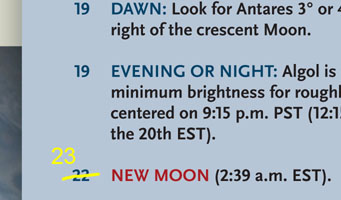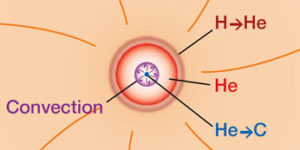 The editors of Sky & Telescope make every effort to provide accurate information, but errors do sometimes slip through. We correct all mistakes online as well as printing corrections in the magazine. So if you see something questionable in the magazine, check below to see if it's a known problem.
The editors of Sky & Telescope make every effort to provide accurate information, but errors do sometimes slip through. We correct all mistakes online as well as printing corrections in the magazine. So if you see something questionable in the magazine, check below to see if it's a known problem.
This article lists all known errors in issues of Sky & Telescope for 2018. See also the errata listings for other years.
January 2018
 Page 26: The bottom panel in the illustration showing the evolution of stellar interiors has an incorrect label. "He→H" should be "He→C", as shown at right.
Page 26: The bottom panel in the illustration showing the evolution of stellar interiors has an incorrect label. "He→H" should be "He→C", as shown at right.
Page 49: The events listed in the table for the total lunar eclipse are given in standard (not daylight) time.
Page 49: Rayleigh scattering of sunlight by air molecules (not refraction) produces colorful sunrises and sunsets on Earth.
February 2018
Page 19: The discussion of returning a 2006 balloon-borne experiment to Earth should note that engineers had to send a second radio signal to separate the parachute from the payload (not the balloon) once it had landed.
Page 37: In the caption below the Periodic Table of Cosmic Origins, promethium should be identified as Pm (not Pc).
March 2018
Page 24: The 24°×24° field of view of the TESS cameras is equivalent to the area covered by nearly 2,100 (not 50) full Moons.
Page 53: The images of Venus (bottom caption) were obtained using a filter that transmitted wavelengths longer than (not at) 610 nm.
April 2018
Page 68: Due to a production error, the AARP ad was mistakenly glued onto an editorial page.
May 2018
Page 7: In 75, 50 & 25 Years Ago, it was Mr. Hughes, not Hodges, who lost the court case for ownership of the Willamette meteorite.
Page 8: The News Note entitled "Successful Falcon Heavy Launch" contained some inaccurate metric conversions: 100 meters is approximately 328 feet, and 100 meters per second is about 224 miles per hour.
Page 16: The distance to faraway supernovae published in 1998 was not based on theories of how stars explode (as stated) but rather estimated using the shapes of the supernova light curves at different wavelengths, based on a calibrated shape-distance relationship.
Page 25: Polaris is, of course, Alpha Ursae Minoris (correct in the table).
Page 49: In the Great Red Spot predictions for May 5th, the correct meridian-crossing times are 8:05 and 18:05.
Page 51: In the caption, "sunset" should be "sunrise."
June 2018
Page 40: In the sidebar, the Hale reflector is at Palomar Observatory, not Mount Wilson.
July 2018
Page 53: Phobos can appear as much as 22 arcseconds (not 16) from the limb of Mars.
Page 75: The Gallery caption for NGC 1514 should state that new findings show the companion star’s orbital period to be 3,306 days, or just over 9 years.
August 2018
Page 66: The observatory at far left in the photo of Haleakalā is not the Advanced Electro-Optical System telescope; AEOS is inside the silver dome at center right as part of the Air Force MSS site. The structure looming over the smaller Pan-STARRS telescopes is the newly constructed Daniel K. Inouye Solar Telescope (DKIST).
September 2018
Page 28: In the graph “S2’s Orbit,” the tic marks on the y-axis should be labeled (in ascending order) 0, 0.025, 0.05, 0.075, 0.1, 0.125, 0.15, and 0.175. The x-axis should be labeled 0.05, 0.025, 0, -0.025, -0.05, and -0.075.
Page 48: The article about observing Uranus and Neptune should refer to them as “gas giants” and not “ice giants.”
December 2018
Page 24: The actual distance for Altair is 17 light-years.
Page 28: The second column of the last line in the table should, of course, read "Scorpius."
Page 52: The crater labeled as Atlas actually is Hercules. Atlas is the larger crater to the right.
 0
0

Comments
You must be logged in to post a comment.